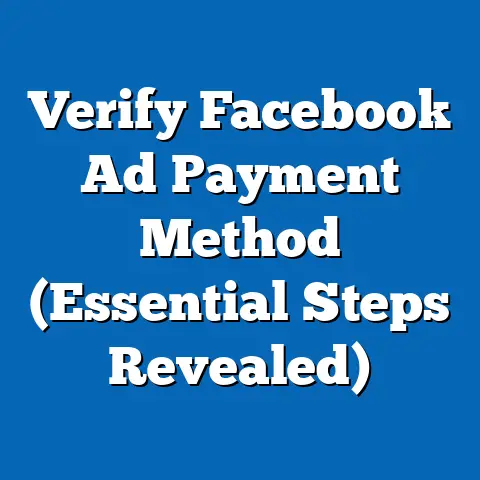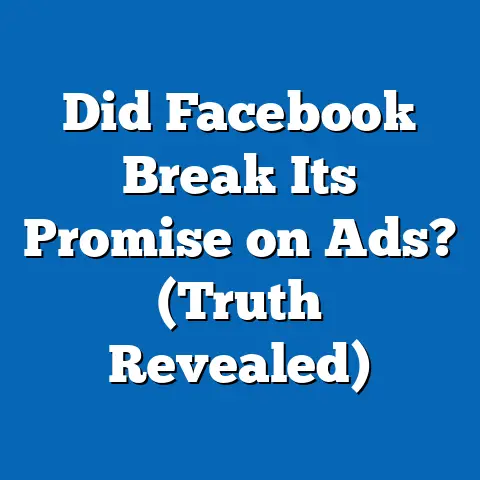Recover Disabled Facebook Ads: Proven Strategies (Expert Tips)
Facebook ads are the lifeblood of many businesses, a digital megaphone that amplifies your message and reaches potential customers worldwide. I’ve seen firsthand how a well-crafted campaign can skyrocket a small business to new heights. But what happens when that megaphone is suddenly silenced? The dreaded “ad disabled” notification can strike fear into the heart of any marketer. Trust me, I’ve been there. The frustration, the confusion, the urgent need to get back online – it’s a situation no one wants to face.
The good news? While a disabled ad can feel like a death sentence, it’s often a temporary setback. I’m going to walk you through proven strategies to recover your disabled Facebook ads, understand why they were flagged in the first place, and, most importantly, prevent this from happening again. I’ll share my own experiences, insights gleaned from years of managing Facebook ad campaigns, and actionable tips that you can implement immediately. According to recent statistics, nearly 30% of Facebook advertisers have experienced ad disapprovals or account limitations at some point. This means you’re not alone, and with the right knowledge, you can navigate this challenge successfully. Let’s get started!
Understanding Facebook’s Ad Policies
Think of Facebook’s ad policies as the rulebook for playing in their advertising sandbox. It’s a comprehensive set of guidelines designed to ensure a positive user experience and prevent harmful or misleading content from circulating on the platform. Ignoring these rules is like showing up to a baseball game with a cricket bat – you’re bound to get flagged.
Compliance is absolutely crucial. Facebook’s algorithms are constantly scanning ads for policy violations, and even unintentional slip-ups can lead to ad disapprovals or, in more severe cases, account disabling. I’ve seen accounts suspended for seemingly minor infractions, simply because the algorithm misinterpreted the ad’s intent.
So, what are some common reasons for ad disapproval or account disabling? Here are a few key areas to watch out for:
- Prohibited Content: This includes anything related to illegal activities, discriminatory practices, tobacco products, drugs, weapons, and content that promotes violence or hatred. I once accidentally used an image that Facebook’s AI flagged as promoting violence, even though it was simply a stock photo of a workout session. The key is to be extremely cautious and avoid anything that could be remotely construed as violating these policies.
- Misleading Claims: Avoid making unsubstantiated claims about your product or service. “Guaranteed weight loss” or “instant riches” are red flags. Honesty and transparency are paramount. I learned this the hard way when an ad promising “amazing results” for a skincare product was rejected. Specifics are better than vague promises.
- Inaccurate Targeting: Ensure your targeting options align with the content of your ad. Targeting users based on sensitive categories like religion or sexual orientation is strictly prohibited. I always double-check my targeting to ensure it’s relevant and respectful.
- Grammar and Spelling: Poor grammar and spelling can make your ad look unprofessional and can even trigger flags for suspicious activity. Always proofread your ads carefully before submitting them. I’ve found that using a tool like Grammarly can be incredibly helpful in catching errors.
- Landing Page Issues: Your landing page must be functional, relevant to your ad, and compliant with Facebook’s policies. Broken links, misleading content, or pages that collect excessive personal information can lead to disapprovals. I always test my landing pages thoroughly before launching a campaign.
It’s crucial to regularly review Facebook’s advertising policies and community standards to stay informed of any changes. Facebook updates its policies frequently, and what was acceptable last month might be a violation today. I make it a habit to check the policy updates at least once a quarter to ensure my campaigns are compliant. You can find the most up-to-date information on the Facebook Business Help Center.
Key Takeaway: Understand Facebook’s ad policies inside and out. Regular review and meticulous compliance are essential for avoiding ad disapprovals and account disabling.
Assessing the Situation
Okay, your ad is disabled. Panic is understandable, but now it’s time to put on your detective hat and figure out what went wrong. The first step is to thoroughly assess the situation.
Here’s a step-by-step process for checking your ad account status and understanding the reasons for the disablement:
- Check Your Ad Account Quality: Navigate to the Ad Account Quality page in Facebook Business Manager. This page provides a comprehensive overview of your account’s status, including any policy violations, ad disapprovals, and account restrictions. I check this page daily, even when I don’t have active campaigns, just to make sure everything is in good standing.
- Review the Notification: Carefully read the notification you received from Facebook regarding the disabled ad. It should provide specific details about the policy violation. Sometimes, the explanation is vague, but it’s a starting point.
- Examine the Ad: Analyze the disabled ad in detail. Look at the ad copy, the image or video, the targeting options, and the landing page. Try to identify any elements that might have triggered the violation. I often ask a fresh pair of eyes to review the ad, as they might spot something I’ve overlooked.
- Gather Documentation: Collect any relevant documentation that supports your case for reinstatement. This might include product certifications, testimonials, legal disclaimers, or proof of compliance with industry regulations. Having this documentation readily available will streamline the appeal process.
It’s important to understand the specific reasons for the disablement. Was it a violation of the prohibited content policy? A misleading claim? A targeting issue? Knowing the exact reason will help you craft a more effective appeal.
I remember one instance where an ad was disabled because Facebook’s AI mistakenly identified a character in a cartoon image as a real child. It took some back-and-forth with Facebook Support, but by providing evidence that it was indeed a cartoon character, I was able to get the ad reinstated.
Key Takeaway: Don’t just react – investigate. Understanding the specific reasons for the disablement is crucial for a successful appeal.
Steps to Appeal the Decision
You’ve assessed the situation, identified the potential violation, and gathered your documentation. Now it’s time to fight back! The appeal process is your opportunity to present your case to Facebook and request a review of their decision.
Here’s a detailed breakdown of the appeal process:
- Locate the Appeal Option: In the Ad Account Quality page or the ad’s details, you should find an option to appeal the decision. This might be a button labeled “Request Review” or “Appeal.”
- Craft a Compelling Appeal Message: This is your chance to explain your side of the story. Be clear, concise, and professional. Avoid emotional language or accusations. Instead, focus on presenting the facts and explaining why you believe the ad does not violate Facebook’s policies.
- Acknowledge the Violation: Even if you disagree with the decision, acknowledge that the ad might have been perceived as violating the policy. This shows that you’re taking the issue seriously.
- Explain Your Intent: Clearly explain the purpose of the ad and what you were trying to achieve.
- Provide Evidence: Include any relevant documentation that supports your case.
- Request a Review: Politely request a review of the decision and express your commitment to complying with Facebook’s policies.
- Submit Your Appeal: Follow the instructions provided by Facebook to submit your appeal. Be sure to include all necessary information and documentation.
- Be Patient: The review process can take time, sometimes several days or even weeks. Avoid submitting multiple appeals, as this can actually slow down the process.
- Acknowledge the Violation: Even if you disagree with the decision, acknowledge that the ad might have been perceived as violating the policy. This shows that you’re taking the issue seriously.
- Explain Your Intent: Clearly explain the purpose of the ad and what you were trying to achieve.
- Provide Evidence: Include any relevant documentation that supports your case.
- Request a Review: Politely request a review of the decision and express your commitment to complying with Facebook’s policies.
Here are a few tips for crafting a compelling appeal message:
- Be Specific: Don’t just say “My ad doesn’t violate any policies.” Explain why you believe it doesn’t.
- Be Respectful: Maintain a professional and respectful tone throughout your message.
- Highlight Your Compliance Efforts: Mention any steps you’ve taken to ensure compliance with Facebook’s policies, such as reviewing the guidelines or consulting with legal counsel.
- Offer to Make Changes: If you’re unsure about the violation, offer to make changes to the ad to address any concerns.
I once had an ad rejected because Facebook’s algorithm misinterpreted the context of a historical image. In my appeal, I provided historical context and explained the educational purpose of the ad. After a few days, the ad was reinstated.
Key Takeaway: Your appeal message is your advocate. Craft it carefully, be professional, and provide clear evidence to support your case.
Preventative Measures
The best way to deal with disabled ads is to prevent them from being disabled in the first place. Proactive measures are key to maintaining a healthy ad account and avoiding unnecessary disruptions to your campaigns.
Here are some strategies to prevent future ad disablements:
- Create High-Quality, Compliant Content: This is the foundation of any successful Facebook ad campaign. Ensure your ad copy is accurate, engaging, and free of misleading claims. Use high-quality images and videos that are relevant to your target audience.
- Utilize Facebook’s Ad Preview Tool: Before submitting your ad, use Facebook’s Ad Preview tool to see how it will appear to users on different devices and placements. This can help you identify any potential issues with the ad’s formatting or content.
- Regularly Audit Your Ad Campaigns: Conduct regular audits of your ad campaigns to ensure they are still compliant with Facebook’s policies. Look for any potential violations and make necessary adjustments. I set a reminder in my calendar to audit my campaigns at least once a month.
- Stay Up-to-Date on Policy Changes: As I mentioned earlier, Facebook’s ad policies are constantly evolving. Make it a habit to check the Facebook Business Help Center regularly for updates and changes.
- Use Facebook’s Compliance Resources: Facebook offers a variety of resources to help advertisers understand and comply with their policies. Take advantage of these resources, such as the Facebook Blueprint courses and the Facebook for Business blog.
- Consider Using a Compliance Tool: There are several third-party tools available that can help you monitor your ad campaigns for policy violations and ensure compliance. These tools can be particularly helpful if you’re managing a large number of campaigns.
- Implement a Review Process: Before launching any new ad campaign, have a colleague or team member review the ad copy, images, and targeting options to ensure they are compliant with Facebook’s policies.
I’ve found that creating a checklist of compliance guidelines and using it to review every ad before submission has significantly reduced the number of ad disapprovals I’ve experienced.
Key Takeaway: Prevention is better than cure. Proactive measures are essential for maintaining a healthy ad account and avoiding unnecessary disruptions to your campaigns.
Leveraging Facebook Support
Sometimes, despite your best efforts, you’ll encounter situations that require direct assistance from Facebook Support. Navigating the support system can be challenging, but with the right approach, you can get the help you need.
Here are some tips for effectively engaging with Facebook’s support team:
- Use the Facebook Business Help Center: The Facebook Business Help Center is a treasure trove of information on a wide range of topics related to Facebook advertising. Before contacting support, search the Help Center for answers to your questions.
- Explore Community Forums: Facebook’s community forums are a great place to connect with other advertisers and get advice on common issues. You might find that someone else has already encountered the same problem and has a solution to share.
- Contact Support Through Business Manager: The best way to contact Facebook Support is through your Business Manager account. This ensures that you’re communicating with the right team and that your account information is readily available.
- Be Clear and Concise: When contacting support, be clear and concise in your explanation of the issue. Provide all relevant details, such as the ad ID, the policy violation, and any steps you’ve already taken to resolve the problem.
- Be Patient and Persistent: The support process can take time, so be patient and persistent. Follow up on your inquiries regularly and don’t give up until you’ve received a satisfactory resolution.
- Document Everything: Keep a record of all your communications with Facebook Support, including the dates, times, and names of the representatives you spoke with. This documentation can be helpful if you need to escalate the issue.
- Escalate When Necessary: If you’re not satisfied with the response you’ve received from support, don’t hesitate to escalate the issue to a supervisor or manager.
I remember one instance where I was unable to resolve an issue with a billing error. After several frustrating interactions with support, I finally escalated the issue to a manager, who was able to quickly resolve the problem.
Key Takeaway: Facebook Support can be a valuable resource, but it’s important to approach the process strategically and be persistent in your pursuit of a resolution.
Conclusion
Navigating the world of Facebook advertising can feel like traversing a complex maze. Understanding the rules, anticipating potential pitfalls, and knowing how to react when things go wrong are all essential skills for success. Disabled ads are a common challenge, but they don’t have to be a setback. By understanding Facebook’s ad policies, assessing the situation, appealing decisions effectively, implementing preventative measures, and leveraging Facebook Support, you can revive your reach and get your campaigns back on track.
Remember, compliance is key. Stay informed, be proactive, and always strive to create high-quality, compliant content that resonates with your target audience. While disabled ads can be a frustrating hurdle, they can be overcome with the right approach and knowledge. Embrace the challenge, learn from your mistakes, and continue to refine your Facebook advertising strategy. Your success is just around the corner!






